Business Communication Skills: Models, Methods, and Barriers Report
VerifiedAdded on 2020/11/23
|14
|3681
|353
Report
AI Summary
This report provides a comprehensive overview of business communication, exploring various models, methods, and systems used within organizations. It delves into the significance of effective communication in exchanging crucial information and fostering positive employee relations. The report examines different communication models, including Aristotle's Persuasion Model, Shannon and Weaver's Information Theory Model, and the Circular Model, highlighting their applications and impact. It also analyzes diverse communication methods such as written, verbal, non-verbal, and electronic methods, emphasizing their benefits and effectiveness. Furthermore, the report discusses the role of technology in facilitating communication, including cloud computing and social media, and outlines the principles of effective communication. Finally, it identifies and addresses barriers to communication, such as physical, linguistic, and emotional barriers, providing insights into overcoming these challenges to ensure clear and efficient information flow within a business context.
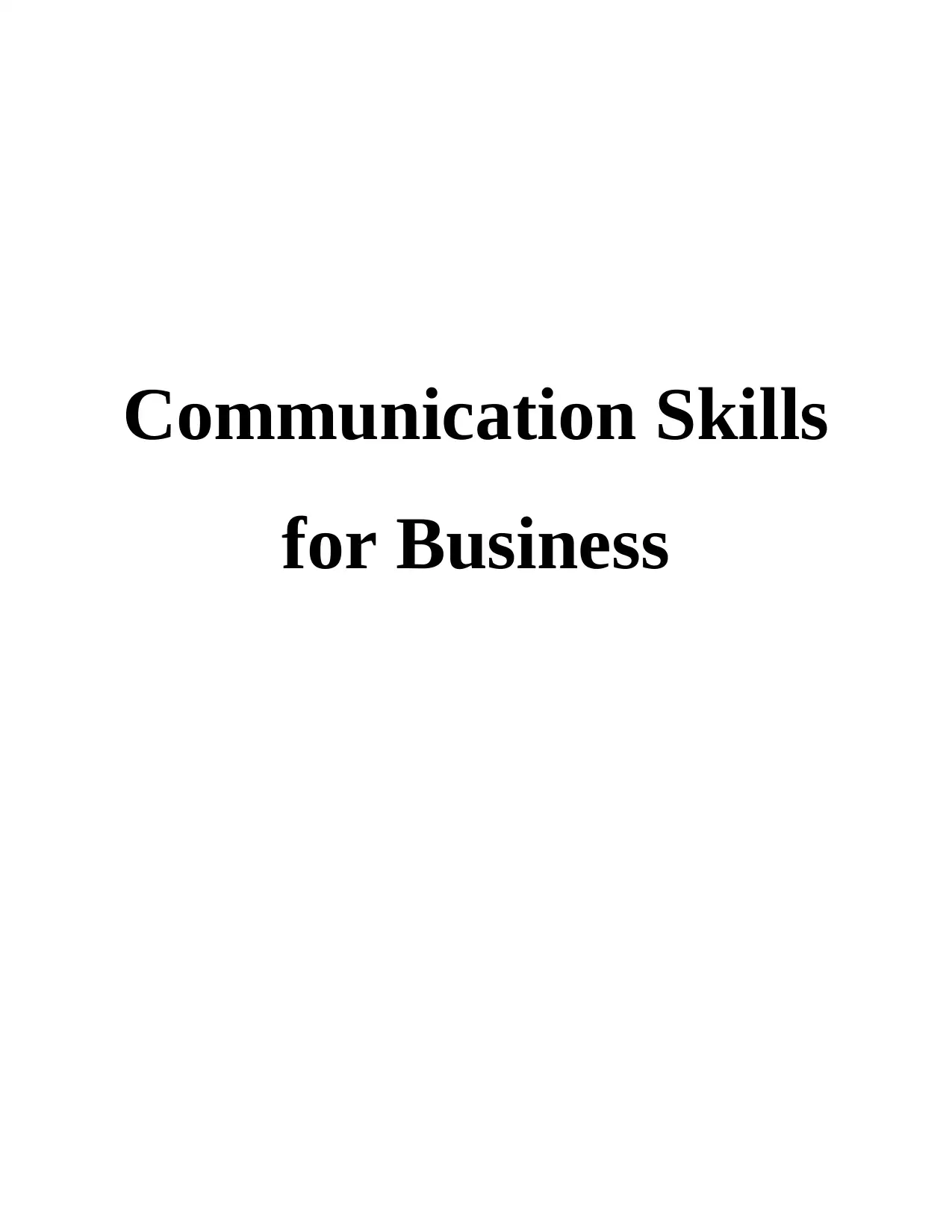
Communication Skills
for Business
for Business
Paraphrase This Document
Need a fresh take? Get an instant paraphrase of this document with our AI Paraphraser
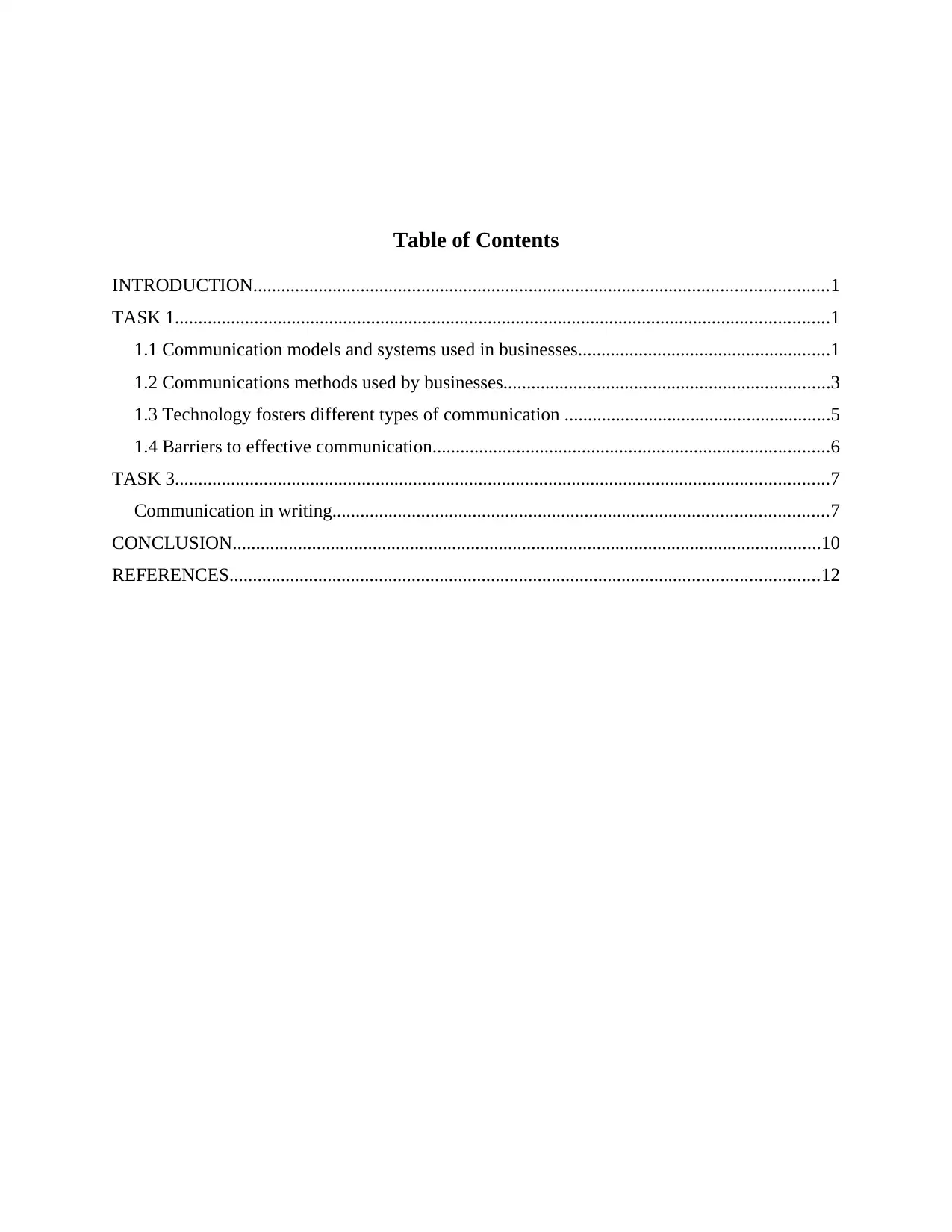
Table of Contents
INTRODUCTION...........................................................................................................................1
TASK 1............................................................................................................................................1
1.1 Communication models and systems used in businesses......................................................1
1.2 Communications methods used by businesses......................................................................3
1.3 Technology fosters different types of communication .........................................................5
1.4 Barriers to effective communication.....................................................................................6
TASK 3............................................................................................................................................7
Communication in writing..........................................................................................................7
CONCLUSION..............................................................................................................................10
REFERENCES..............................................................................................................................12
INTRODUCTION...........................................................................................................................1
TASK 1............................................................................................................................................1
1.1 Communication models and systems used in businesses......................................................1
1.2 Communications methods used by businesses......................................................................3
1.3 Technology fosters different types of communication .........................................................5
1.4 Barriers to effective communication.....................................................................................6
TASK 3............................................................................................................................................7
Communication in writing..........................................................................................................7
CONCLUSION..............................................................................................................................10
REFERENCES..............................................................................................................................12

⊘ This is a preview!⊘
Do you want full access?
Subscribe today to unlock all pages.

Trusted by 1+ million students worldwide
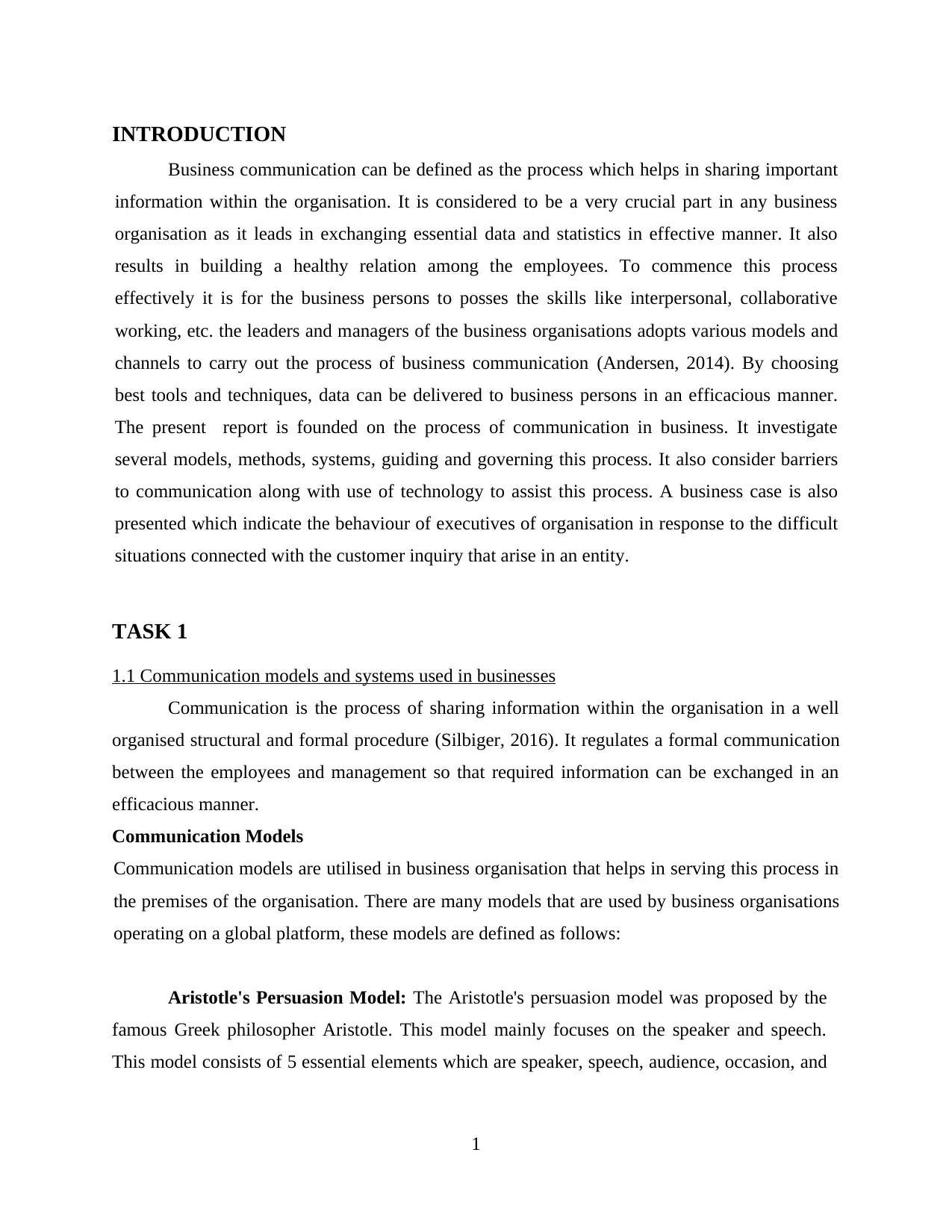
INTRODUCTION
Business communication can be defined as the process which helps in sharing important
information within the organisation. It is considered to be a very crucial part in any business
organisation as it leads in exchanging essential data and statistics in effective manner. It also
results in building a healthy relation among the employees. To commence this process
effectively it is for the business persons to posses the skills like interpersonal, collaborative
working, etc. the leaders and managers of the business organisations adopts various models and
channels to carry out the process of business communication (Andersen, 2014). By choosing
best tools and techniques, data can be delivered to business persons in an efficacious manner.
The present report is founded on the process of communication in business. It investigate
several models, methods, systems, guiding and governing this process. It also consider barriers
to communication along with use of technology to assist this process. A business case is also
presented which indicate the behaviour of executives of organisation in response to the difficult
situations connected with the customer inquiry that arise in an entity.
TASK 1
1.1 Communication models and systems used in businesses
Communication is the process of sharing information within the organisation in a well
organised structural and formal procedure (Silbiger, 2016). It regulates a formal communication
between the employees and management so that required information can be exchanged in an
efficacious manner.
Communication Models
Communication models are utilised in business organisation that helps in serving this process in
the premises of the organisation. There are many models that are used by business organisations
operating on a global platform, these models are defined as follows:
Aristotle's Persuasion Model: The Aristotle's persuasion model was proposed by the
famous Greek philosopher Aristotle. This model mainly focuses on the speaker and speech.
This model consists of 5 essential elements which are speaker, speech, audience, occasion, and
1
Business communication can be defined as the process which helps in sharing important
information within the organisation. It is considered to be a very crucial part in any business
organisation as it leads in exchanging essential data and statistics in effective manner. It also
results in building a healthy relation among the employees. To commence this process
effectively it is for the business persons to posses the skills like interpersonal, collaborative
working, etc. the leaders and managers of the business organisations adopts various models and
channels to carry out the process of business communication (Andersen, 2014). By choosing
best tools and techniques, data can be delivered to business persons in an efficacious manner.
The present report is founded on the process of communication in business. It investigate
several models, methods, systems, guiding and governing this process. It also consider barriers
to communication along with use of technology to assist this process. A business case is also
presented which indicate the behaviour of executives of organisation in response to the difficult
situations connected with the customer inquiry that arise in an entity.
TASK 1
1.1 Communication models and systems used in businesses
Communication is the process of sharing information within the organisation in a well
organised structural and formal procedure (Silbiger, 2016). It regulates a formal communication
between the employees and management so that required information can be exchanged in an
efficacious manner.
Communication Models
Communication models are utilised in business organisation that helps in serving this process in
the premises of the organisation. There are many models that are used by business organisations
operating on a global platform, these models are defined as follows:
Aristotle's Persuasion Model: The Aristotle's persuasion model was proposed by the
famous Greek philosopher Aristotle. This model mainly focuses on the speaker and speech.
This model consists of 5 essential elements which are speaker, speech, audience, occasion, and
1
Paraphrase This Document
Need a fresh take? Get an instant paraphrase of this document with our AI Paraphraser
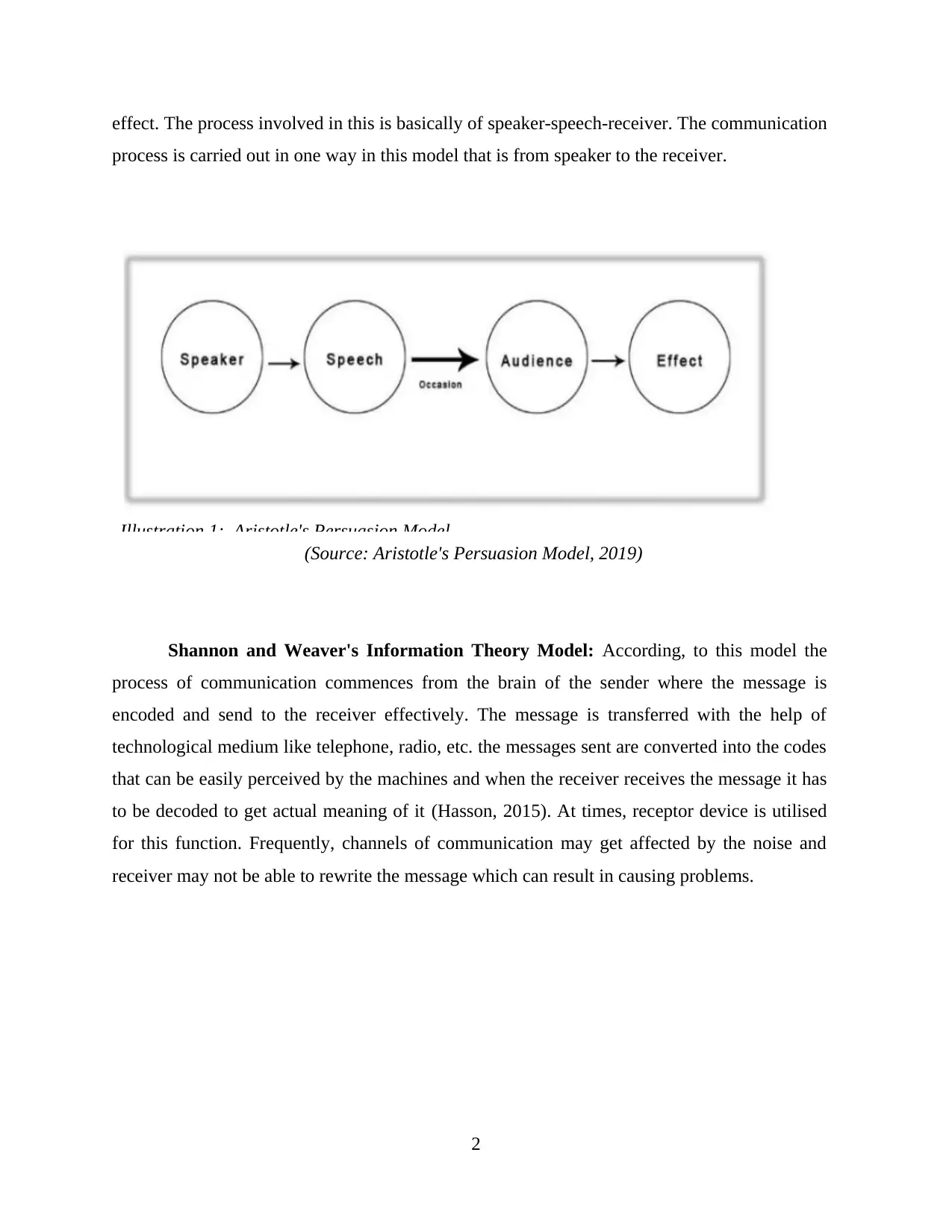
effect. The process involved in this is basically of speaker-speech-receiver. The communication
process is carried out in one way in this model that is from speaker to the receiver.
Illustration 1: Aristotle's Persuasion Model
(Source: Aristotle's Persuasion Model, 2019)
Shannon and Weaver's Information Theory Model: According, to this model the
process of communication commences from the brain of the sender where the message is
encoded and send to the receiver effectively. The message is transferred with the help of
technological medium like telephone, radio, etc. the messages sent are converted into the codes
that can be easily perceived by the machines and when the receiver receives the message it has
to be decoded to get actual meaning of it (Hasson, 2015). At times, receptor device is utilised
for this function. Frequently, channels of communication may get affected by the noise and
receiver may not be able to rewrite the message which can result in causing problems.
2
process is carried out in one way in this model that is from speaker to the receiver.
Illustration 1: Aristotle's Persuasion Model
(Source: Aristotle's Persuasion Model, 2019)
Shannon and Weaver's Information Theory Model: According, to this model the
process of communication commences from the brain of the sender where the message is
encoded and send to the receiver effectively. The message is transferred with the help of
technological medium like telephone, radio, etc. the messages sent are converted into the codes
that can be easily perceived by the machines and when the receiver receives the message it has
to be decoded to get actual meaning of it (Hasson, 2015). At times, receptor device is utilised
for this function. Frequently, channels of communication may get affected by the noise and
receiver may not be able to rewrite the message which can result in causing problems.
2
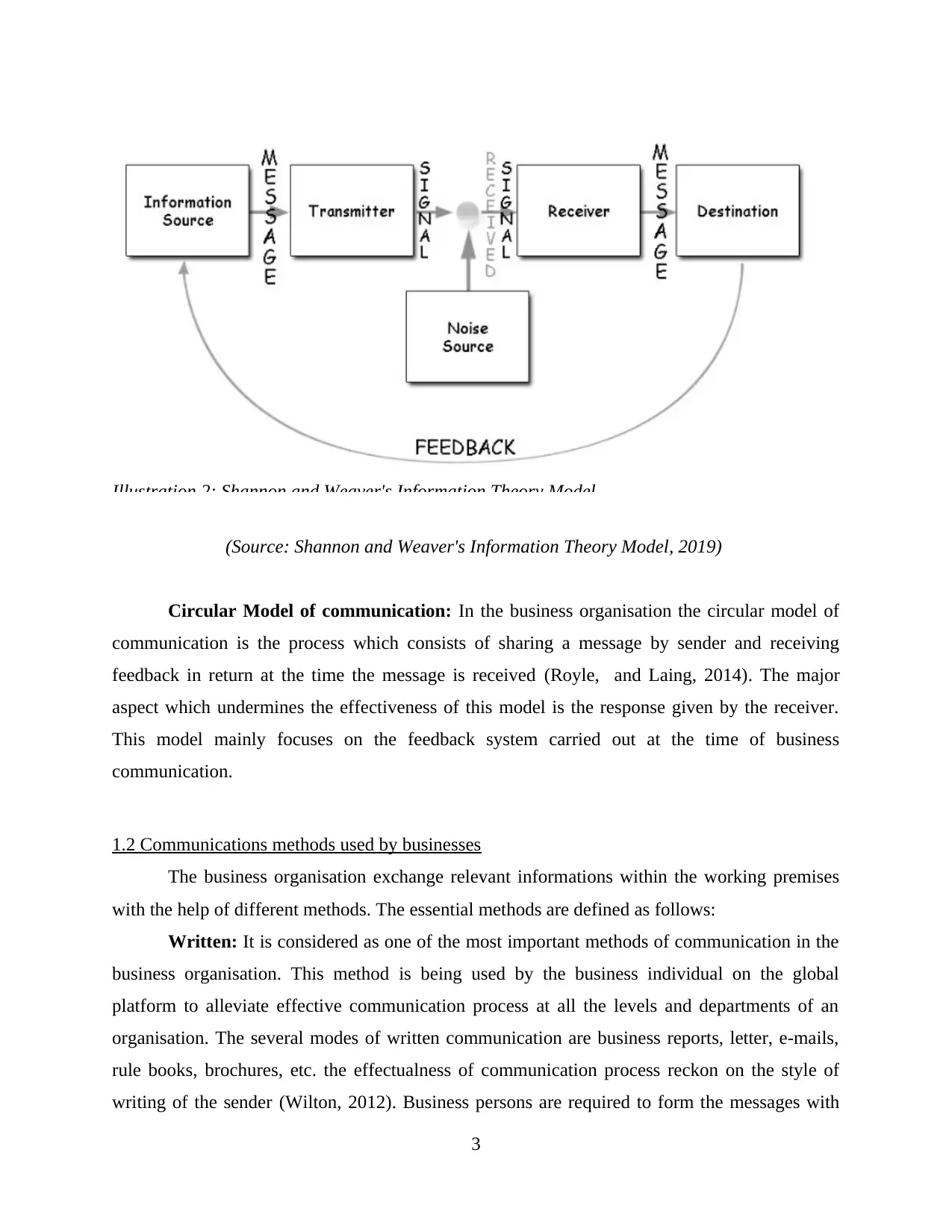
Illustration 2: Shannon and Weaver's Information Theory Model
(Source: Shannon and Weaver's Information Theory Model, 2019)
Circular Model of communication: In the business organisation the circular model of
communication is the process which consists of sharing a message by sender and receiving
feedback in return at the time the message is received (Royle, and Laing, 2014). The major
aspect which undermines the effectiveness of this model is the response given by the receiver.
This model mainly focuses on the feedback system carried out at the time of business
communication.
1.2 Communications methods used by businesses
The business organisation exchange relevant informations within the working premises
with the help of different methods. The essential methods are defined as follows:
Written: It is considered as one of the most important methods of communication in the
business organisation. This method is being used by the business individual on the global
platform to alleviate effective communication process at all the levels and departments of an
organisation. The several modes of written communication are business reports, letter, e-mails,
rule books, brochures, etc. the effectualness of communication process reckon on the style of
writing of the sender (Wilton, 2012). Business persons are required to form the messages with
3
(Source: Shannon and Weaver's Information Theory Model, 2019)
Circular Model of communication: In the business organisation the circular model of
communication is the process which consists of sharing a message by sender and receiving
feedback in return at the time the message is received (Royle, and Laing, 2014). The major
aspect which undermines the effectiveness of this model is the response given by the receiver.
This model mainly focuses on the feedback system carried out at the time of business
communication.
1.2 Communications methods used by businesses
The business organisation exchange relevant informations within the working premises
with the help of different methods. The essential methods are defined as follows:
Written: It is considered as one of the most important methods of communication in the
business organisation. This method is being used by the business individual on the global
platform to alleviate effective communication process at all the levels and departments of an
organisation. The several modes of written communication are business reports, letter, e-mails,
rule books, brochures, etc. the effectualness of communication process reckon on the style of
writing of the sender (Wilton, 2012). Business persons are required to form the messages with
3
⊘ This is a preview!⊘
Do you want full access?
Subscribe today to unlock all pages.

Trusted by 1+ million students worldwide
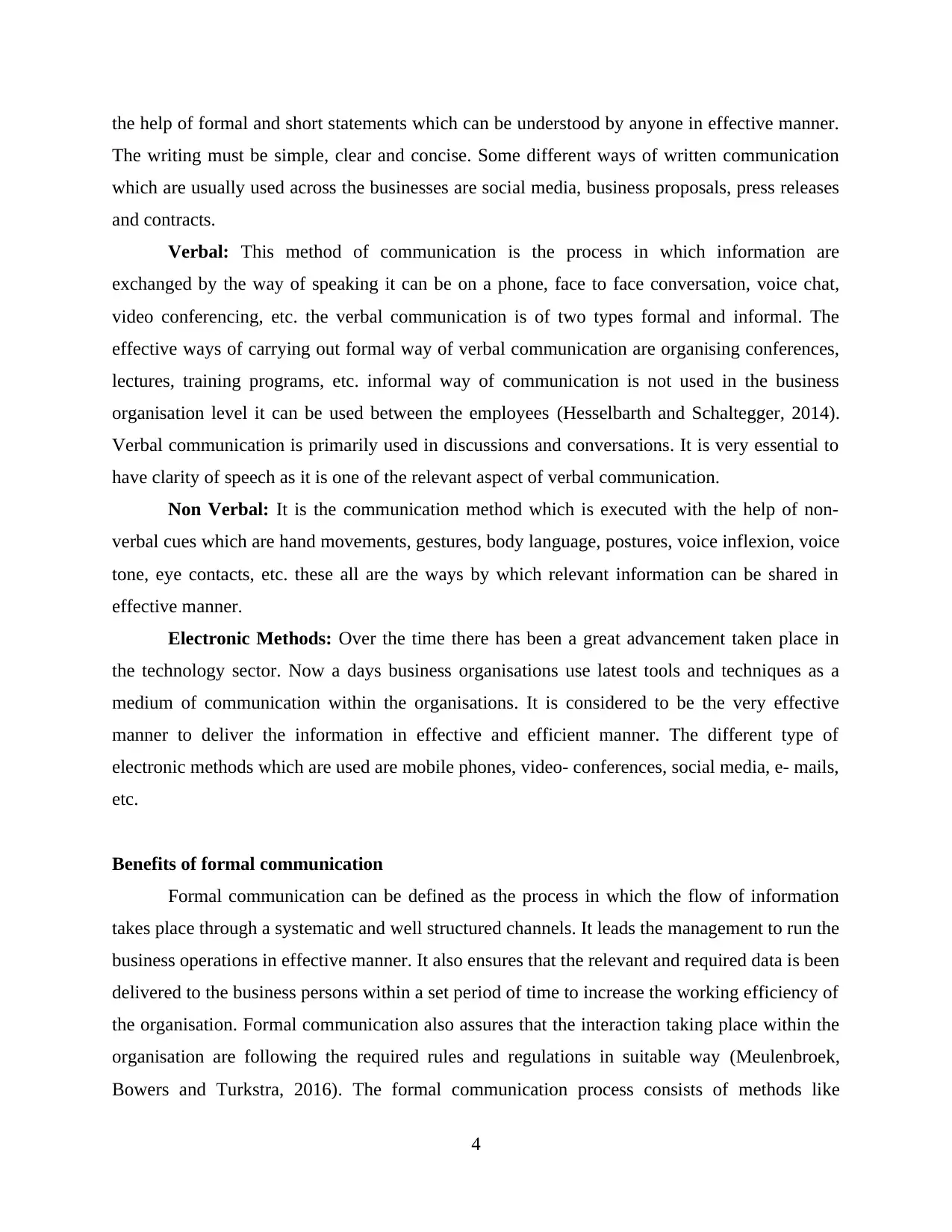
the help of formal and short statements which can be understood by anyone in effective manner.
The writing must be simple, clear and concise. Some different ways of written communication
which are usually used across the businesses are social media, business proposals, press releases
and contracts.
Verbal: This method of communication is the process in which information are
exchanged by the way of speaking it can be on a phone, face to face conversation, voice chat,
video conferencing, etc. the verbal communication is of two types formal and informal. The
effective ways of carrying out formal way of verbal communication are organising conferences,
lectures, training programs, etc. informal way of communication is not used in the business
organisation level it can be used between the employees (Hesselbarth and Schaltegger, 2014).
Verbal communication is primarily used in discussions and conversations. It is very essential to
have clarity of speech as it is one of the relevant aspect of verbal communication.
Non Verbal: It is the communication method which is executed with the help of non-
verbal cues which are hand movements, gestures, body language, postures, voice inflexion, voice
tone, eye contacts, etc. these all are the ways by which relevant information can be shared in
effective manner.
Electronic Methods: Over the time there has been a great advancement taken place in
the technology sector. Now a days business organisations use latest tools and techniques as a
medium of communication within the organisations. It is considered to be the very effective
manner to deliver the information in effective and efficient manner. The different type of
electronic methods which are used are mobile phones, video- conferences, social media, e- mails,
etc.
Benefits of formal communication
Formal communication can be defined as the process in which the flow of information
takes place through a systematic and well structured channels. It leads the management to run the
business operations in effective manner. It also ensures that the relevant and required data is been
delivered to the business persons within a set period of time to increase the working efficiency of
the organisation. Formal communication also assures that the interaction taking place within the
organisation are following the required rules and regulations in suitable way (Meulenbroek,
Bowers and Turkstra, 2016). The formal communication process consists of methods like
4
The writing must be simple, clear and concise. Some different ways of written communication
which are usually used across the businesses are social media, business proposals, press releases
and contracts.
Verbal: This method of communication is the process in which information are
exchanged by the way of speaking it can be on a phone, face to face conversation, voice chat,
video conferencing, etc. the verbal communication is of two types formal and informal. The
effective ways of carrying out formal way of verbal communication are organising conferences,
lectures, training programs, etc. informal way of communication is not used in the business
organisation level it can be used between the employees (Hesselbarth and Schaltegger, 2014).
Verbal communication is primarily used in discussions and conversations. It is very essential to
have clarity of speech as it is one of the relevant aspect of verbal communication.
Non Verbal: It is the communication method which is executed with the help of non-
verbal cues which are hand movements, gestures, body language, postures, voice inflexion, voice
tone, eye contacts, etc. these all are the ways by which relevant information can be shared in
effective manner.
Electronic Methods: Over the time there has been a great advancement taken place in
the technology sector. Now a days business organisations use latest tools and techniques as a
medium of communication within the organisations. It is considered to be the very effective
manner to deliver the information in effective and efficient manner. The different type of
electronic methods which are used are mobile phones, video- conferences, social media, e- mails,
etc.
Benefits of formal communication
Formal communication can be defined as the process in which the flow of information
takes place through a systematic and well structured channels. It leads the management to run the
business operations in effective manner. It also ensures that the relevant and required data is been
delivered to the business persons within a set period of time to increase the working efficiency of
the organisation. Formal communication also assures that the interaction taking place within the
organisation are following the required rules and regulations in suitable way (Meulenbroek,
Bowers and Turkstra, 2016). The formal communication process consists of methods like
4
Paraphrase This Document
Need a fresh take? Get an instant paraphrase of this document with our AI Paraphraser
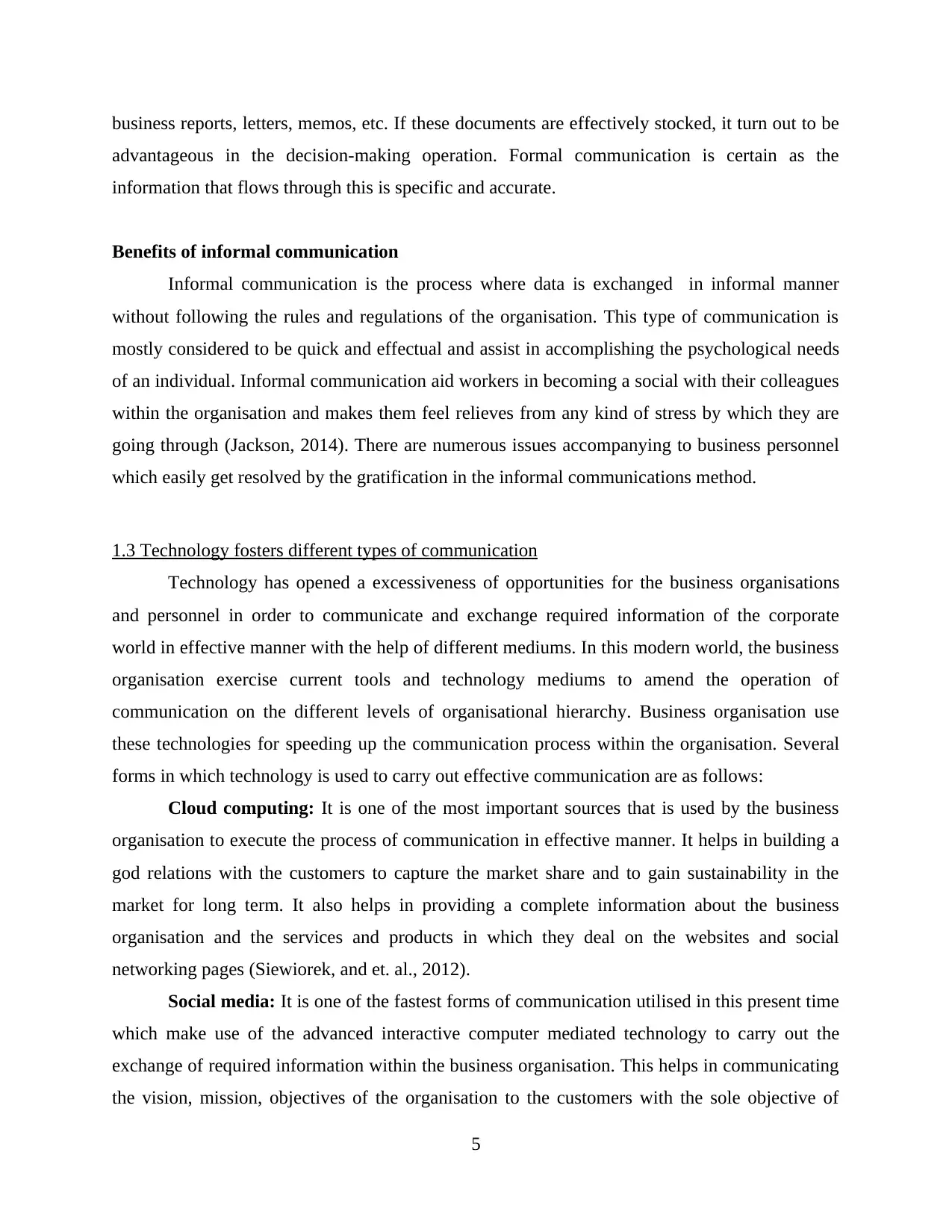
business reports, letters, memos, etc. If these documents are effectively stocked, it turn out to be
advantageous in the decision-making operation. Formal communication is certain as the
information that flows through this is specific and accurate.
Benefits of informal communication
Informal communication is the process where data is exchanged in informal manner
without following the rules and regulations of the organisation. This type of communication is
mostly considered to be quick and effectual and assist in accomplishing the psychological needs
of an individual. Informal communication aid workers in becoming a social with their colleagues
within the organisation and makes them feel relieves from any kind of stress by which they are
going through (Jackson, 2014). There are numerous issues accompanying to business personnel
which easily get resolved by the gratification in the informal communications method.
1.3 Technology fosters different types of communication
Technology has opened a excessiveness of opportunities for the business organisations
and personnel in order to communicate and exchange required information of the corporate
world in effective manner with the help of different mediums. In this modern world, the business
organisation exercise current tools and technology mediums to amend the operation of
communication on the different levels of organisational hierarchy. Business organisation use
these technologies for speeding up the communication process within the organisation. Several
forms in which technology is used to carry out effective communication are as follows:
Cloud computing: It is one of the most important sources that is used by the business
organisation to execute the process of communication in effective manner. It helps in building a
god relations with the customers to capture the market share and to gain sustainability in the
market for long term. It also helps in providing a complete information about the business
organisation and the services and products in which they deal on the websites and social
networking pages (Siewiorek, and et. al., 2012).
Social media: It is one of the fastest forms of communication utilised in this present time
which make use of the advanced interactive computer mediated technology to carry out the
exchange of required information within the business organisation. This helps in communicating
the vision, mission, objectives of the organisation to the customers with the sole objective of
5
advantageous in the decision-making operation. Formal communication is certain as the
information that flows through this is specific and accurate.
Benefits of informal communication
Informal communication is the process where data is exchanged in informal manner
without following the rules and regulations of the organisation. This type of communication is
mostly considered to be quick and effectual and assist in accomplishing the psychological needs
of an individual. Informal communication aid workers in becoming a social with their colleagues
within the organisation and makes them feel relieves from any kind of stress by which they are
going through (Jackson, 2014). There are numerous issues accompanying to business personnel
which easily get resolved by the gratification in the informal communications method.
1.3 Technology fosters different types of communication
Technology has opened a excessiveness of opportunities for the business organisations
and personnel in order to communicate and exchange required information of the corporate
world in effective manner with the help of different mediums. In this modern world, the business
organisation exercise current tools and technology mediums to amend the operation of
communication on the different levels of organisational hierarchy. Business organisation use
these technologies for speeding up the communication process within the organisation. Several
forms in which technology is used to carry out effective communication are as follows:
Cloud computing: It is one of the most important sources that is used by the business
organisation to execute the process of communication in effective manner. It helps in building a
god relations with the customers to capture the market share and to gain sustainability in the
market for long term. It also helps in providing a complete information about the business
organisation and the services and products in which they deal on the websites and social
networking pages (Siewiorek, and et. al., 2012).
Social media: It is one of the fastest forms of communication utilised in this present time
which make use of the advanced interactive computer mediated technology to carry out the
exchange of required information within the business organisation. This helps in communicating
the vision, mission, objectives of the organisation to the customers with the sole objective of
5
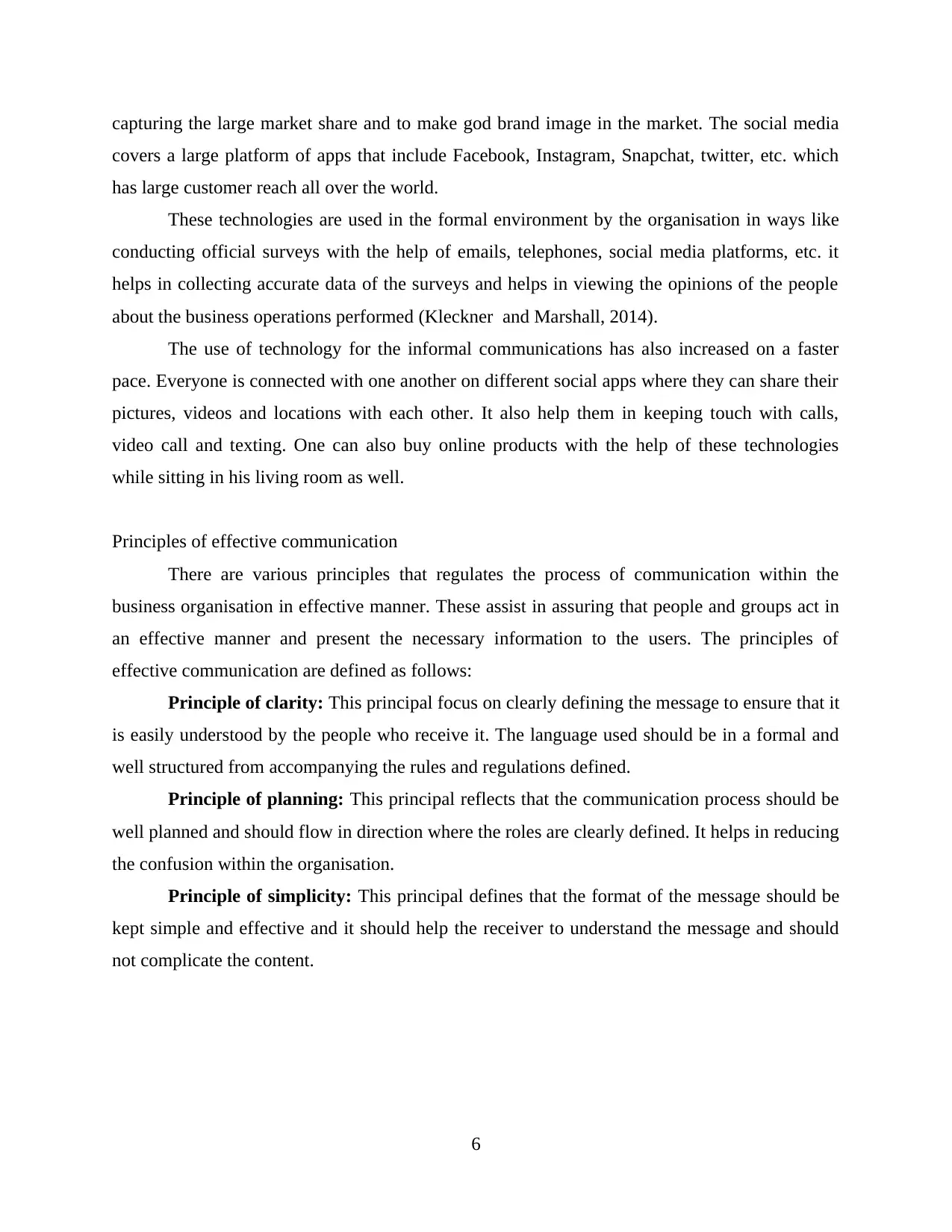
capturing the large market share and to make god brand image in the market. The social media
covers a large platform of apps that include Facebook, Instagram, Snapchat, twitter, etc. which
has large customer reach all over the world.
These technologies are used in the formal environment by the organisation in ways like
conducting official surveys with the help of emails, telephones, social media platforms, etc. it
helps in collecting accurate data of the surveys and helps in viewing the opinions of the people
about the business operations performed (Kleckner and Marshall, 2014).
The use of technology for the informal communications has also increased on a faster
pace. Everyone is connected with one another on different social apps where they can share their
pictures, videos and locations with each other. It also help them in keeping touch with calls,
video call and texting. One can also buy online products with the help of these technologies
while sitting in his living room as well.
Principles of effective communication
There are various principles that regulates the process of communication within the
business organisation in effective manner. These assist in assuring that people and groups act in
an effective manner and present the necessary information to the users. The principles of
effective communication are defined as follows:
Principle of clarity: This principal focus on clearly defining the message to ensure that it
is easily understood by the people who receive it. The language used should be in a formal and
well structured from accompanying the rules and regulations defined.
Principle of planning: This principal reflects that the communication process should be
well planned and should flow in direction where the roles are clearly defined. It helps in reducing
the confusion within the organisation.
Principle of simplicity: This principal defines that the format of the message should be
kept simple and effective and it should help the receiver to understand the message and should
not complicate the content.
6
covers a large platform of apps that include Facebook, Instagram, Snapchat, twitter, etc. which
has large customer reach all over the world.
These technologies are used in the formal environment by the organisation in ways like
conducting official surveys with the help of emails, telephones, social media platforms, etc. it
helps in collecting accurate data of the surveys and helps in viewing the opinions of the people
about the business operations performed (Kleckner and Marshall, 2014).
The use of technology for the informal communications has also increased on a faster
pace. Everyone is connected with one another on different social apps where they can share their
pictures, videos and locations with each other. It also help them in keeping touch with calls,
video call and texting. One can also buy online products with the help of these technologies
while sitting in his living room as well.
Principles of effective communication
There are various principles that regulates the process of communication within the
business organisation in effective manner. These assist in assuring that people and groups act in
an effective manner and present the necessary information to the users. The principles of
effective communication are defined as follows:
Principle of clarity: This principal focus on clearly defining the message to ensure that it
is easily understood by the people who receive it. The language used should be in a formal and
well structured from accompanying the rules and regulations defined.
Principle of planning: This principal reflects that the communication process should be
well planned and should flow in direction where the roles are clearly defined. It helps in reducing
the confusion within the organisation.
Principle of simplicity: This principal defines that the format of the message should be
kept simple and effective and it should help the receiver to understand the message and should
not complicate the content.
6
⊘ This is a preview!⊘
Do you want full access?
Subscribe today to unlock all pages.

Trusted by 1+ million students worldwide
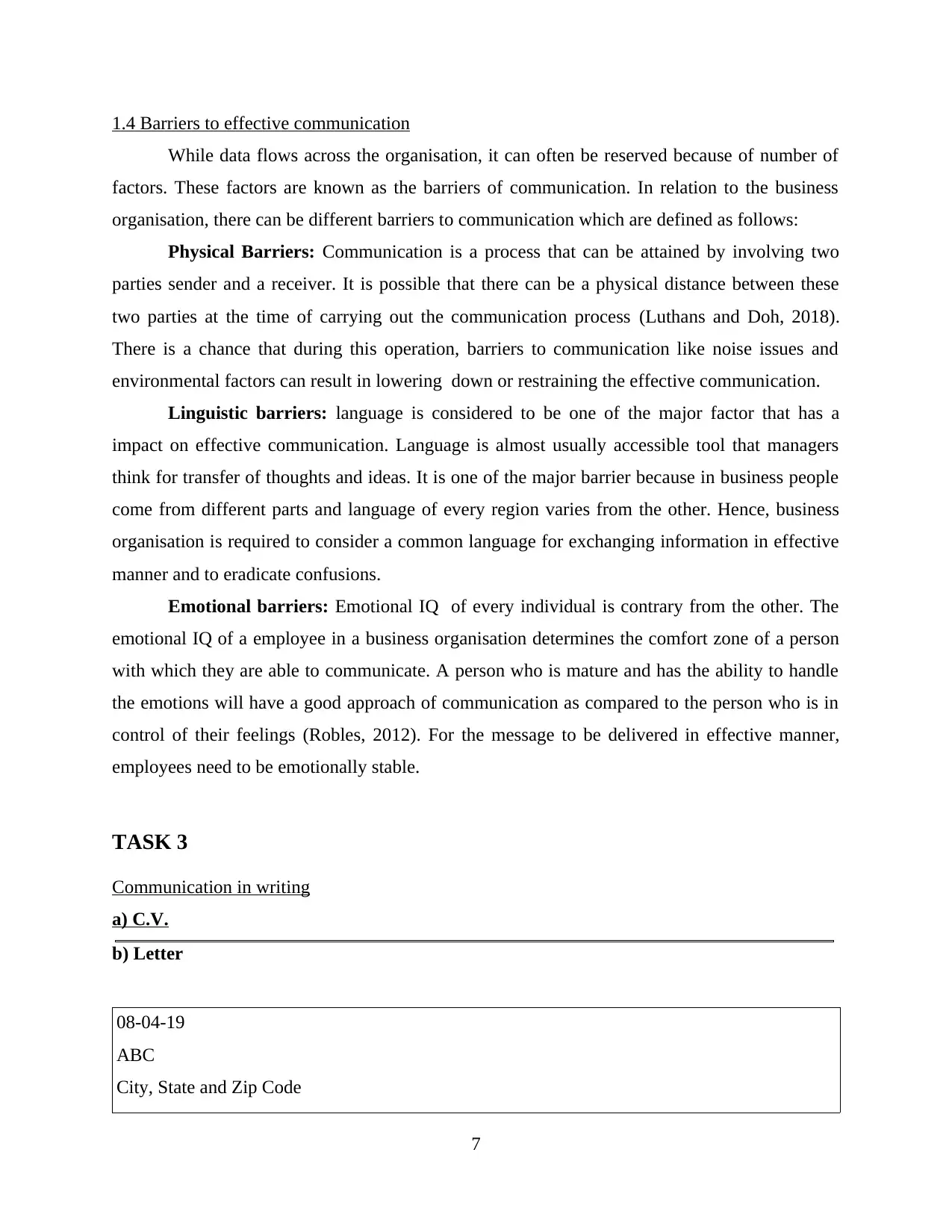
1.4 Barriers to effective communication
While data flows across the organisation, it can often be reserved because of number of
factors. These factors are known as the barriers of communication. In relation to the business
organisation, there can be different barriers to communication which are defined as follows:
Physical Barriers: Communication is a process that can be attained by involving two
parties sender and a receiver. It is possible that there can be a physical distance between these
two parties at the time of carrying out the communication process (Luthans and Doh, 2018).
There is a chance that during this operation, barriers to communication like noise issues and
environmental factors can result in lowering down or restraining the effective communication.
Linguistic barriers: language is considered to be one of the major factor that has a
impact on effective communication. Language is almost usually accessible tool that managers
think for transfer of thoughts and ideas. It is one of the major barrier because in business people
come from different parts and language of every region varies from the other. Hence, business
organisation is required to consider a common language for exchanging information in effective
manner and to eradicate confusions.
Emotional barriers: Emotional IQ of every individual is contrary from the other. The
emotional IQ of a employee in a business organisation determines the comfort zone of a person
with which they are able to communicate. A person who is mature and has the ability to handle
the emotions will have a good approach of communication as compared to the person who is in
control of their feelings (Robles, 2012). For the message to be delivered in effective manner,
employees need to be emotionally stable.
TASK 3
Communication in writing
a) C.V.
Curriculum Vitae (CV)b) Letter
08-04-19
ABC
City, State and Zip Code
7
While data flows across the organisation, it can often be reserved because of number of
factors. These factors are known as the barriers of communication. In relation to the business
organisation, there can be different barriers to communication which are defined as follows:
Physical Barriers: Communication is a process that can be attained by involving two
parties sender and a receiver. It is possible that there can be a physical distance between these
two parties at the time of carrying out the communication process (Luthans and Doh, 2018).
There is a chance that during this operation, barriers to communication like noise issues and
environmental factors can result in lowering down or restraining the effective communication.
Linguistic barriers: language is considered to be one of the major factor that has a
impact on effective communication. Language is almost usually accessible tool that managers
think for transfer of thoughts and ideas. It is one of the major barrier because in business people
come from different parts and language of every region varies from the other. Hence, business
organisation is required to consider a common language for exchanging information in effective
manner and to eradicate confusions.
Emotional barriers: Emotional IQ of every individual is contrary from the other. The
emotional IQ of a employee in a business organisation determines the comfort zone of a person
with which they are able to communicate. A person who is mature and has the ability to handle
the emotions will have a good approach of communication as compared to the person who is in
control of their feelings (Robles, 2012). For the message to be delivered in effective manner,
employees need to be emotionally stable.
TASK 3
Communication in writing
a) C.V.
Curriculum Vitae (CV)b) Letter
08-04-19
ABC
City, State and Zip Code
7
Paraphrase This Document
Need a fresh take? Get an instant paraphrase of this document with our AI Paraphraser
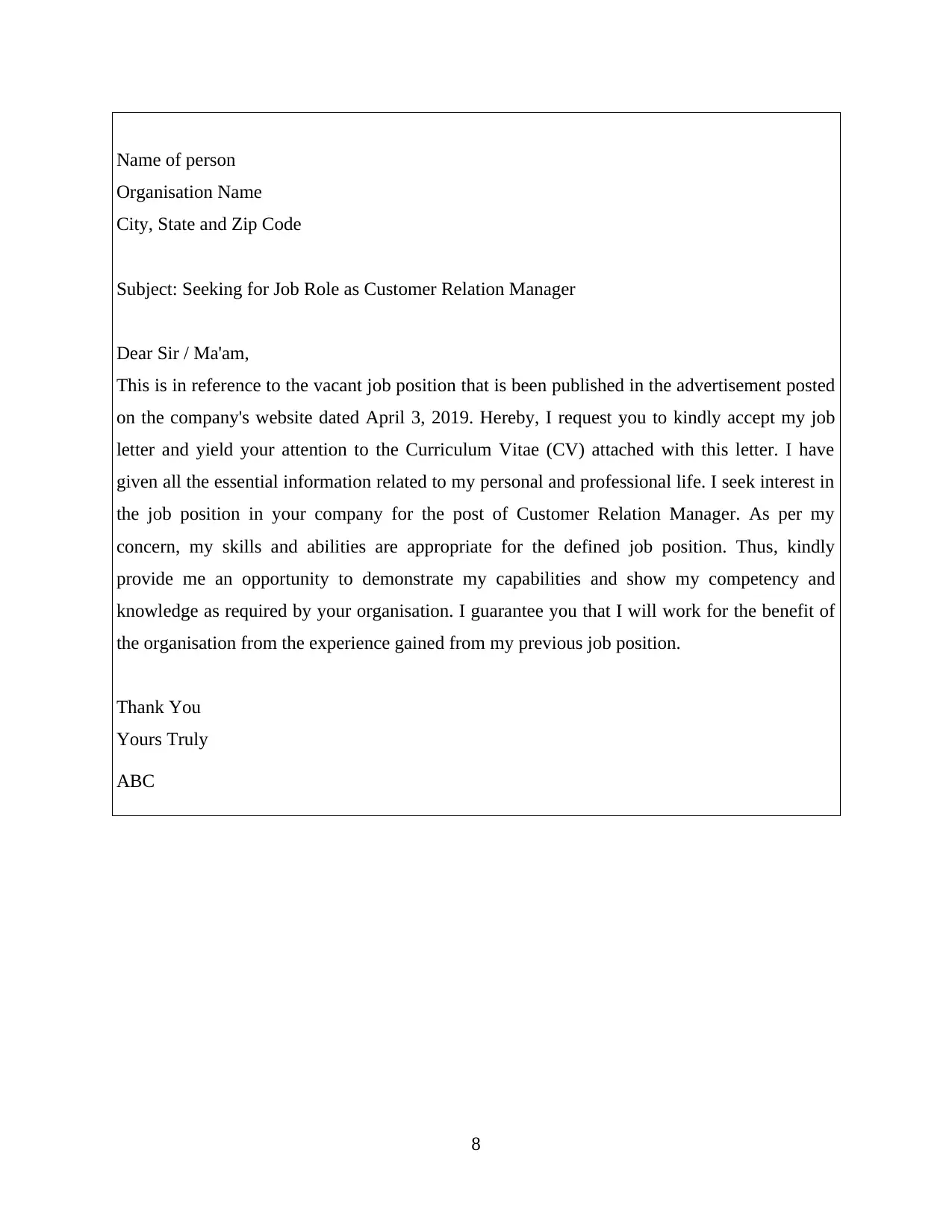
Name of person
Organisation Name
City, State and Zip Code
Subject: Seeking for Job Role as Customer Relation Manager
Dear Sir / Ma'am,
This is in reference to the vacant job position that is been published in the advertisement posted
on the company's website dated April 3, 2019. Hereby, I request you to kindly accept my job
letter and yield your attention to the Curriculum Vitae (CV) attached with this letter. I have
given all the essential information related to my personal and professional life. I seek interest in
the job position in your company for the post of Customer Relation Manager. As per my
concern, my skills and abilities are appropriate for the defined job position. Thus, kindly
provide me an opportunity to demonstrate my capabilities and show my competency and
knowledge as required by your organisation. I guarantee you that I will work for the benefit of
the organisation from the experience gained from my previous job position.
Thank You
Yours Truly
ABC
8
Organisation Name
City, State and Zip Code
Subject: Seeking for Job Role as Customer Relation Manager
Dear Sir / Ma'am,
This is in reference to the vacant job position that is been published in the advertisement posted
on the company's website dated April 3, 2019. Hereby, I request you to kindly accept my job
letter and yield your attention to the Curriculum Vitae (CV) attached with this letter. I have
given all the essential information related to my personal and professional life. I seek interest in
the job position in your company for the post of Customer Relation Manager. As per my
concern, my skills and abilities are appropriate for the defined job position. Thus, kindly
provide me an opportunity to demonstrate my capabilities and show my competency and
knowledge as required by your organisation. I guarantee you that I will work for the benefit of
the organisation from the experience gained from my previous job position.
Thank You
Yours Truly
ABC
8
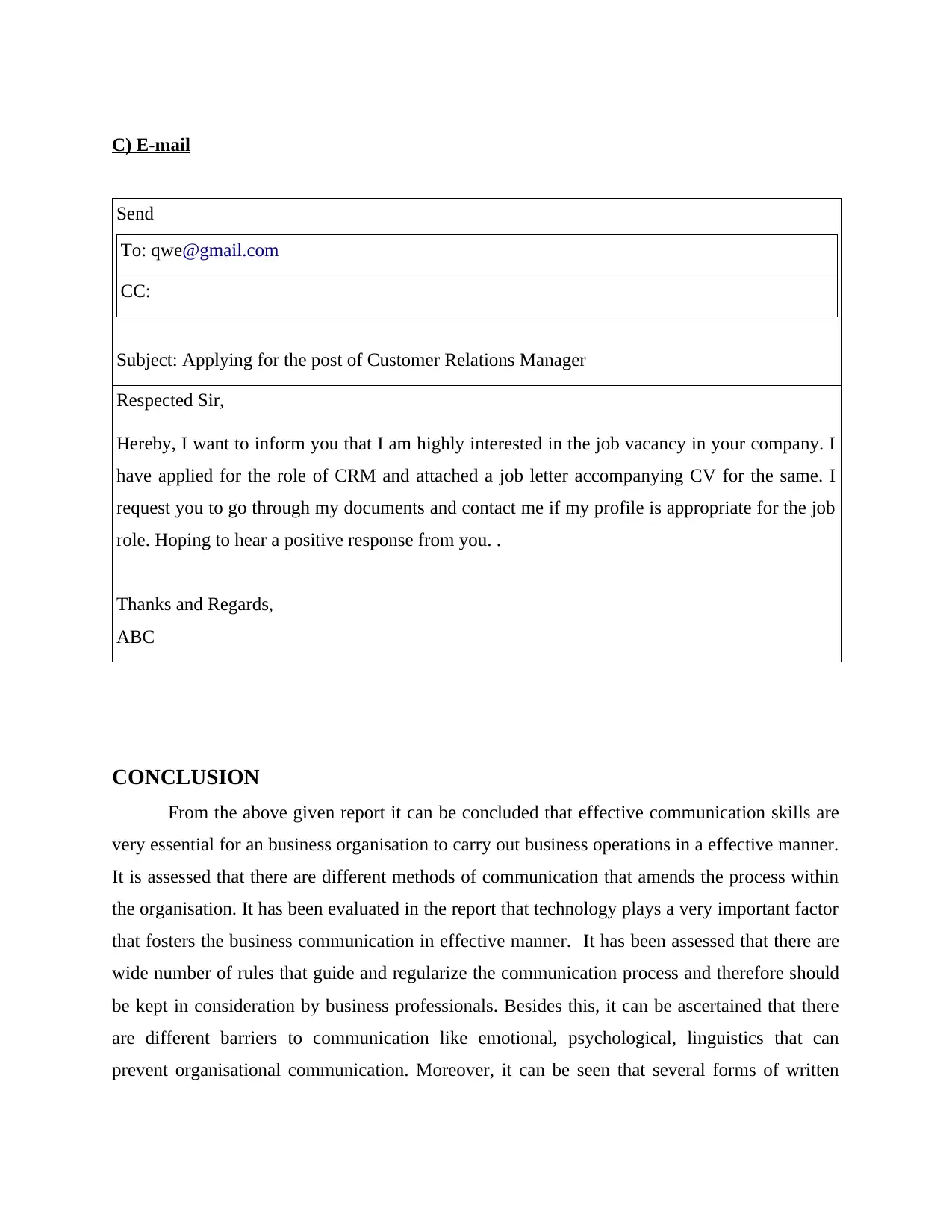
C) E-mail
Send
To: qwe@gmail.com
CC:
Subject: Applying for the post of Customer Relations Manager
Respected Sir,
Hereby, I want to inform you that I am highly interested in the job vacancy in your company. I
have applied for the role of CRM and attached a job letter accompanying CV for the same. I
request you to go through my documents and contact me if my profile is appropriate for the job
role. Hoping to hear a positive response from you. .
Thanks and Regards,
ABC
CONCLUSION
From the above given report it can be concluded that effective communication skills are
very essential for an business organisation to carry out business operations in a effective manner.
It is assessed that there are different methods of communication that amends the process within
the organisation. It has been evaluated in the report that technology plays a very important factor
that fosters the business communication in effective manner. It has been assessed that there are
wide number of rules that guide and regularize the communication process and therefore should
be kept in consideration by business professionals. Besides this, it can be ascertained that there
are different barriers to communication like emotional, psychological, linguistics that can
prevent organisational communication. Moreover, it can be seen that several forms of written
Send
To: qwe@gmail.com
CC:
Subject: Applying for the post of Customer Relations Manager
Respected Sir,
Hereby, I want to inform you that I am highly interested in the job vacancy in your company. I
have applied for the role of CRM and attached a job letter accompanying CV for the same. I
request you to go through my documents and contact me if my profile is appropriate for the job
role. Hoping to hear a positive response from you. .
Thanks and Regards,
ABC
CONCLUSION
From the above given report it can be concluded that effective communication skills are
very essential for an business organisation to carry out business operations in a effective manner.
It is assessed that there are different methods of communication that amends the process within
the organisation. It has been evaluated in the report that technology plays a very important factor
that fosters the business communication in effective manner. It has been assessed that there are
wide number of rules that guide and regularize the communication process and therefore should
be kept in consideration by business professionals. Besides this, it can be ascertained that there
are different barriers to communication like emotional, psychological, linguistics that can
prevent organisational communication. Moreover, it can be seen that several forms of written
⊘ This is a preview!⊘
Do you want full access?
Subscribe today to unlock all pages.

Trusted by 1+ million students worldwide
1 out of 14
Related Documents
Your All-in-One AI-Powered Toolkit for Academic Success.
+13062052269
info@desklib.com
Available 24*7 on WhatsApp / Email
![[object Object]](/_next/static/media/star-bottom.7253800d.svg)
Unlock your academic potential
Copyright © 2020–2025 A2Z Services. All Rights Reserved. Developed and managed by ZUCOL.





